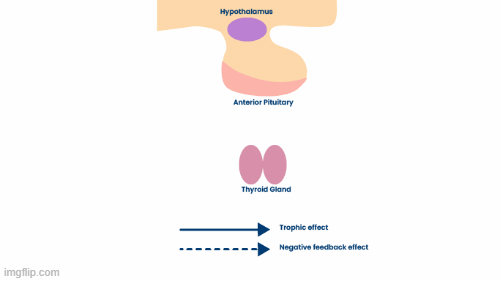What is feline hyperthyroidism?
Hyperthyroidism (thyrotoxicosis) is a disorder resulting from excessive circulating concentrations of the active thyroid hormones tri-iodothyronine (T3) and/or thyroxine (T4).
First described in 1979, hyperthyroidism has become the most common feline endocrine disorder.
What regulates thyroid hormone production?
Normal thyroid hormone production is controlled by a negative feedback system.
Thyroid hormone release is initiated by the hypothalamus which secretes thyrotropin releasing hormone (or TRH), this acts on the anterior pituitary and regulates the production of thyroid stimulating hormone (or TSH).
TSH then acts on the thyroid gland and stimulates the production of T4 and T3. When circulating levels of T4 and T3 exceed a threshold level, they exert a negative feedback effect predominantly on the pituitary (but also on the hypothalamus), to keep the system in balance.

Over 99% of circulating T4 and T3 is bound to the plasma proteins albumin, thyroxine binding protein and thyroxine binding prealbumin. However, it is the free or unbound hormones which are metabolically active and can be taken into cells.
T4 is the major secretory product of the thyroid gland, but the metabolic activity of T3 is much greater. T3 is generally considered to be 5 times more metabolically active than T4.
About 80% of the plasma T3 is produced by deiodination of T4 in peripheral tissues, mainly the liver and kidneys.
What is the cause?
The exact underlying cause remains unknown but epidemiological study suggests a multifactorial aetiology. It is most likely that risk factors for the development of feline hyperthyroidism fall into one of two categories (Peterson, 2012):
- Nutritional deficiencies or excesses in cat food
- Thyroid disrupting compounds present in the environment, water or diet
Despite the fact that the underlying cause(s) of feline hyperthyroidism have not been clearly elucidated, the thyroid pathologic findings associated with hyperthyroidism have been well characterised
As the diagram shows, bilateral benign hyperplasia of the thyroid gland is the most common pathologic change.

What role does ectopic thyroid tissue play in feline hyperthyroidism?
Ectopic hyperplastic thyroid tissue (EHTT) can be found anywhere from the base of the tongue to the base of the heart. Although relatively uncommon (a 2015 review found a prevalence of approximately 4%), the presence of EHTT can determine treatment choice for the individual patient.
